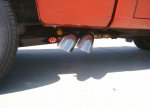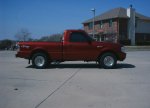cbxer55
Well-Known Member
- Joined
- Oct 9, 2009
- Messages
- 1,865
- Reaction score
- 767
- Points
- 113
- Location
- Midwest City, Oklahoma
- Vehicle Year
- 1998
- Make / Model
- Ford
- Engine Size
- 3.0
- Transmission
- Automatic
According to my scanner, it was bad anyways. So i just removed it and the DPFE, and all the hoses. Yup, still have a code for it being gone. Yup, piece of black tape fixes it up swell. I removed in on my 04 Lightning to make spark plug changes on the driver's side easier. The damn tube blocked off the two back plugs. I also relocated the power steering reservoir off the top of the engine to a bracket I made to put it on the shroud. Makes getting to the front two plugs easier. I can now see all four COPS on the drivers and passenger side. Makes plug changes so much easier.Why would you delete the EGR and pay for 93 octane? EGR is only operational at smaller throttle openings, it basically doesn't hurt power at all.
Deleting the EGR doesn't make the engine need 93 octane though. I know how they work. For whatever reason, I've replaced the stupid DPFE twice since I've owned the truck. Not again. Maybe it was just because the parts were made in mexico parts from Auto Zone? But twice for that stupid thing is twice too many.
















